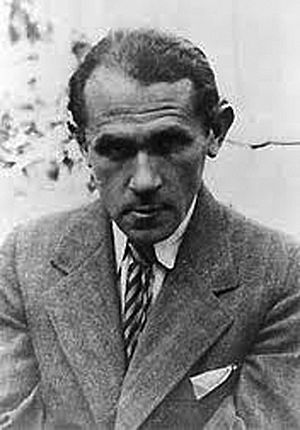Bruno Schulz facts for kids
Quick facts for kids
Bruno Schulz
|
|
|---|---|
 |
|
| Born | 12 July 1892 Drohobych, Kingdom of Galicia and Lodomeria |
| Died | 19 November 1942 (aged 50) Drohobycz, German-occupied Poland |
| Occupation | Writer, fine artist, literary critic, art teacher |
| Genre | Novel, short story |
| Literary movement | modernism, surrealism, magic realism |
| Notable works | Sanatorium Under the Sign of the Hourglass The Street of Crocodiles aka Cinnamon Shops |
Bruno Schulz (born July 12, 1892 – died November 19, 1942) was a talented Polish writer, artist, and teacher. He is known as one of the best Polish-language writers of the 20th century. In 1938, he won a special award called the Golden Laurel from the Polish Academy of Literature.
Sadly, many of Schulz's writings were lost during World War II. This included short stories and his last, unfinished novel, The Messiah. Bruno Schulz was killed by a German officer in 1942 while walking home in his town.
About Bruno Schulz's Life
Schulz was born in Drohobych, a town that was then part of Austria-Hungary. Today, this town is in Ukraine. Before World War I, it was part of the Kingdom of Poland. After the war, Drohobych became part of the newly independent Poland.
Bruno Schulz's father was a cloth merchant. From a young age, Bruno loved art. He went to school in Drohobych and later studied architecture in Lviv and Vienna. However, he had to stop his studies sometimes because of illness.
In 1924, Schulz returned to his old school in Drohobych. He taught crafts and drawing there until 1941. He didn't really enjoy teaching, but it was his only way to earn money. He often entertained his students by telling them stories during class.
Schulz was a unique person. He was Jewish and wrote in Polish, but he also spoke German. He was deeply connected to Jewish culture, even though he didn't speak Yiddish. He found inspiration in his hometown and its people. He preferred to stay in Drohobych rather than travel. His town changed hands many times during his life. It was part of the Austro-Hungarian Empire, then Poland, then the Soviet Union, and finally under German control during World War II. Schulz's stories usually didn't talk about these big world events.
How Bruno Schulz Became a Writer
At first, some people told Schulz not to publish his stories. But then, a famous writer named Zofia Nałkowska saw some letters he had written. In these letters, Schulz described his life and his town in a very special way. Nałkowska encouraged him to publish them as short stories.
His first book, The Cinnamon Shops (Sklepy Cynamonowe), came out in 1934. In English, it's often called The Street of Crocodiles. Three years later, he published Sanatorium Under the Sign of the Hourglass (Sanatorium Pod Klepsydrą). Schulz himself drew the pictures for his books. Sadly, these drawings were often missing or poorly copied in later editions.
In 1936, he helped translate Franz Kafka's book The Trial into Polish. In 1938, he received the important Golden Laurel award for his writing.
In 1939, during World War II, German and Soviet forces invaded Poland. Drohobych was taken over by the Soviet Union. Schulz was working on a novel called The Messiah at this time, but the book was lost after his death.
When Germany attacked the Soviet Union in 1941, Schulz was forced to live in a special area called the Drohobycz Ghetto. This was where Jewish people were made to live. Many Jewish people from Drohobych were later sent to terrible camps. A German officer named Felix Landau admired Schulz's art. He protected Schulz in exchange for Schulz painting a mural in his home.
In 1942, shortly after finishing the mural, Schulz was walking home with some bread. Another German officer, Karl Günther, shot and killed him. Schulz's mural was later painted over and forgotten. It was rediscovered in 2001.
Bruno Schulz's Books in English
Bruno Schulz didn't write a lot of books. His main works are The Street of Crocodiles and Sanatorium Under the Sign of the Hourglass. He also wrote some other short pieces and essays for newspapers. Many of his works, including his last novel The Messiah, were lost.
His stories were first translated into English in the 1960s and 1970s. The Street of Crocodiles came out in 1963, and Sanatorium Under the Sign of the Hourglass in 1979. Later, all his stories were put together in one book called The Complete Fiction of Bruno Schulz. Newer translations of his stories have also been published recently.
Films and Plays Inspired by Schulz
Bruno Schulz's unique stories have inspired many artists.
- In 1973, a Polish film called The Hour-Glass Sanatorium was made. It used many of Schulz's stories to create a dreamlike movie.
- In 1986, the Quay Brothers made a 21-minute animated film called Street of Crocodiles. It was a stop-motion film, meaning it used models moved frame by frame.
His book The Street of Crocodiles was also turned into a play in London in 1992. This play used images, movement, puppets, and music to bring Schulz's world to life. It was very popular and won awards. Many other theatre groups have also created performances based on Schulz's life and works.
Images for kids
See also
 In Spanish: Bruno Schulz para niños
In Spanish: Bruno Schulz para niños




